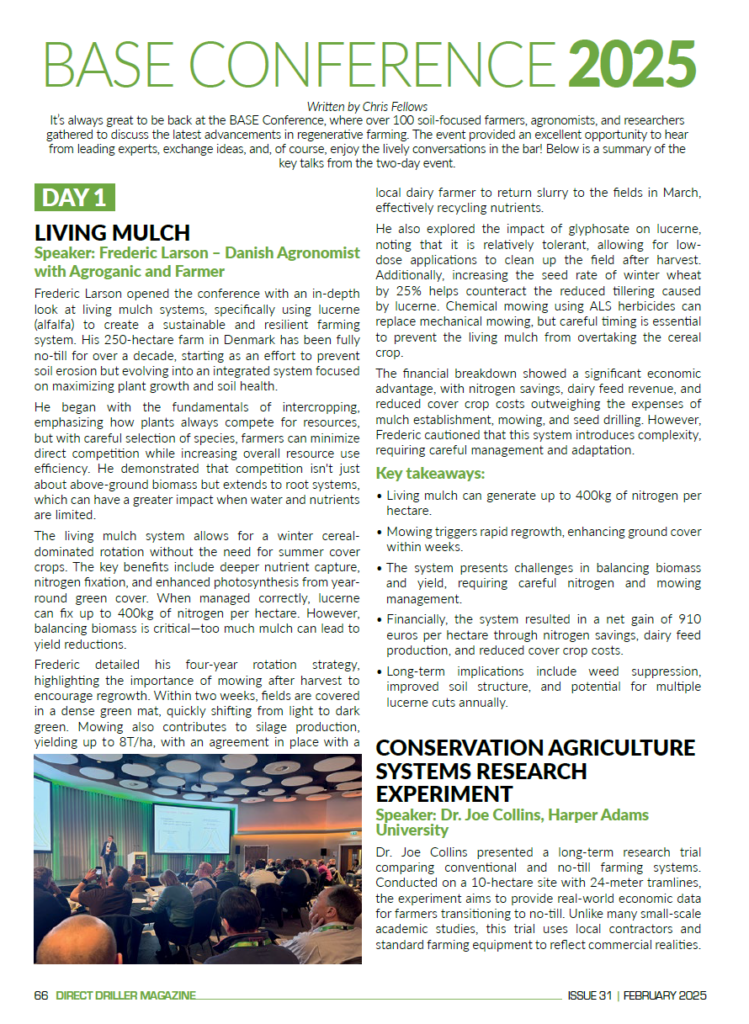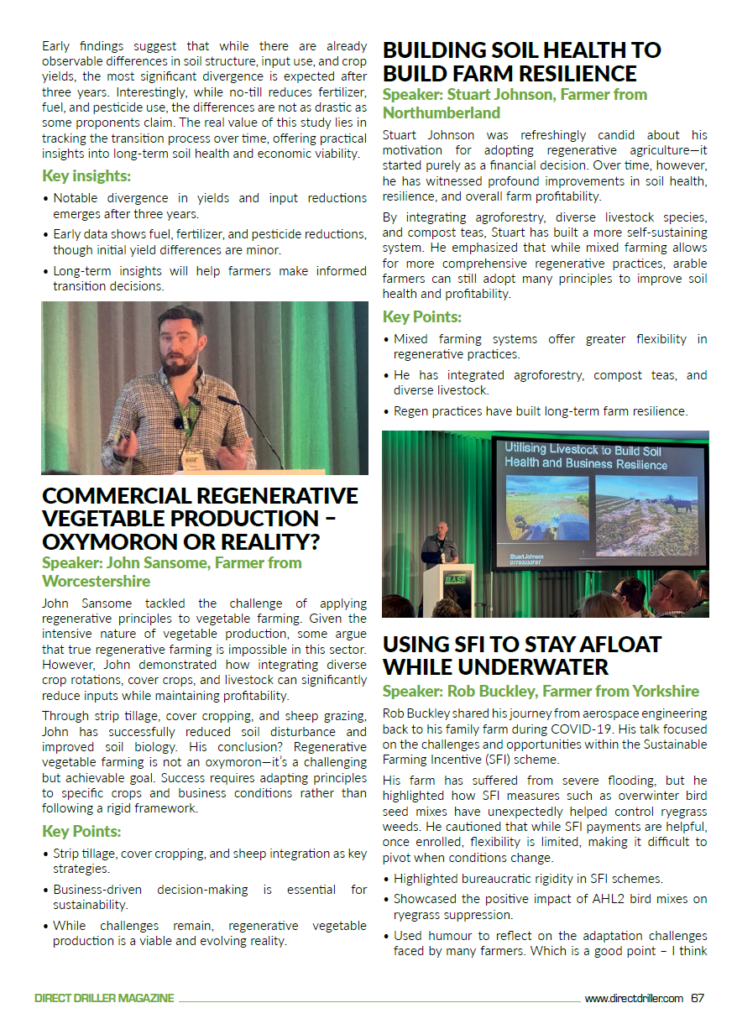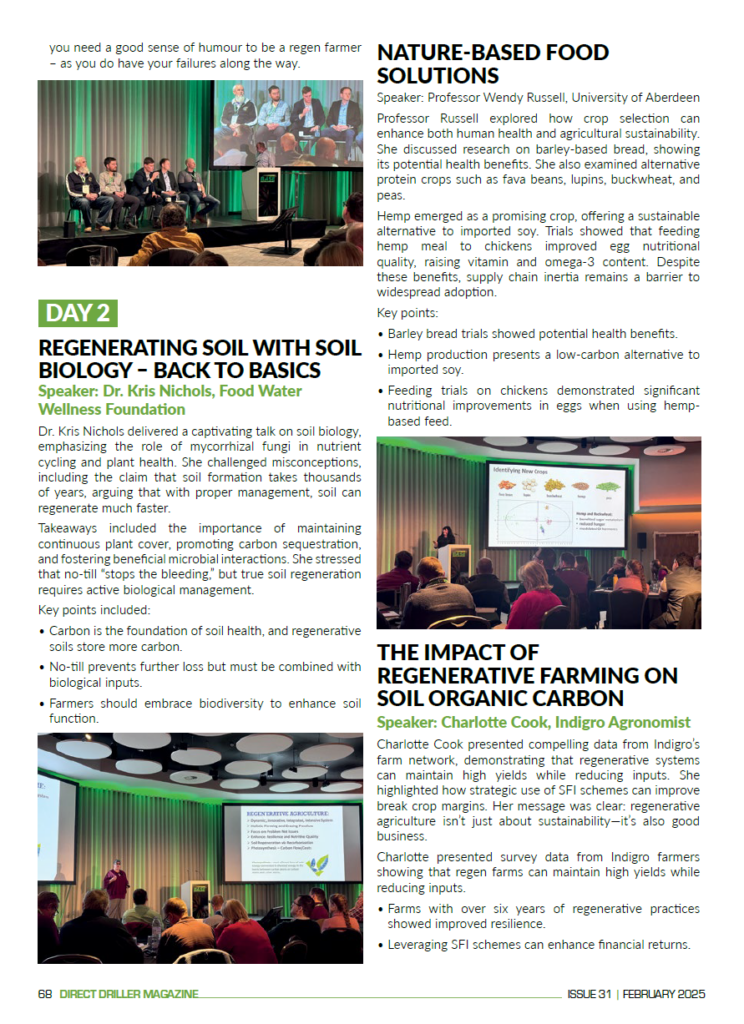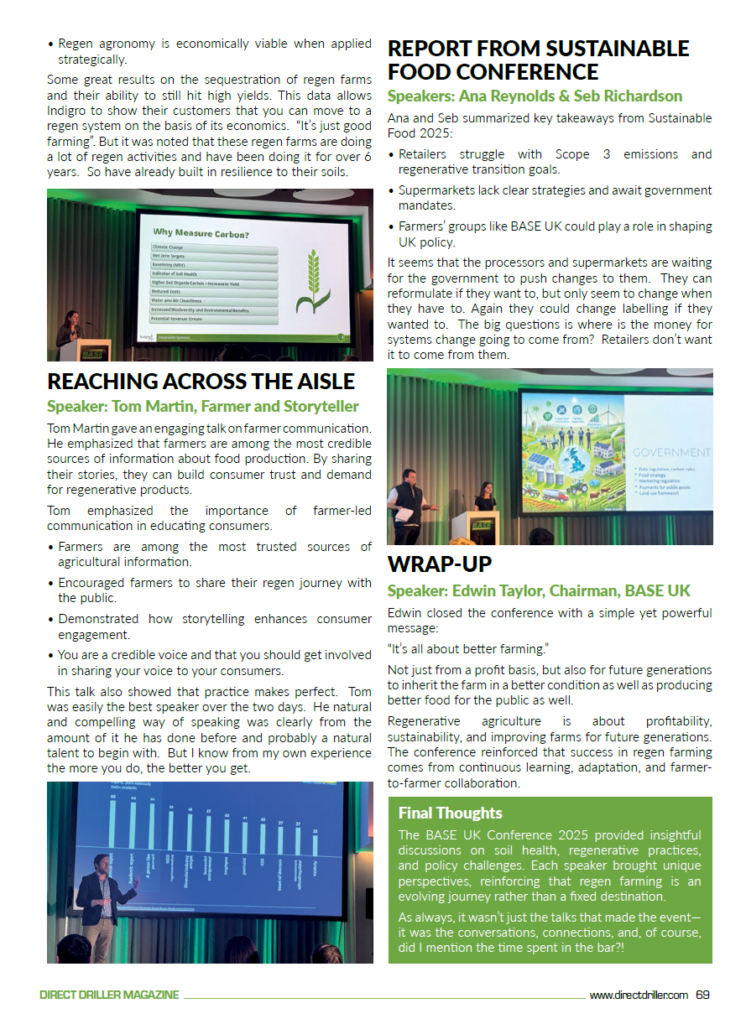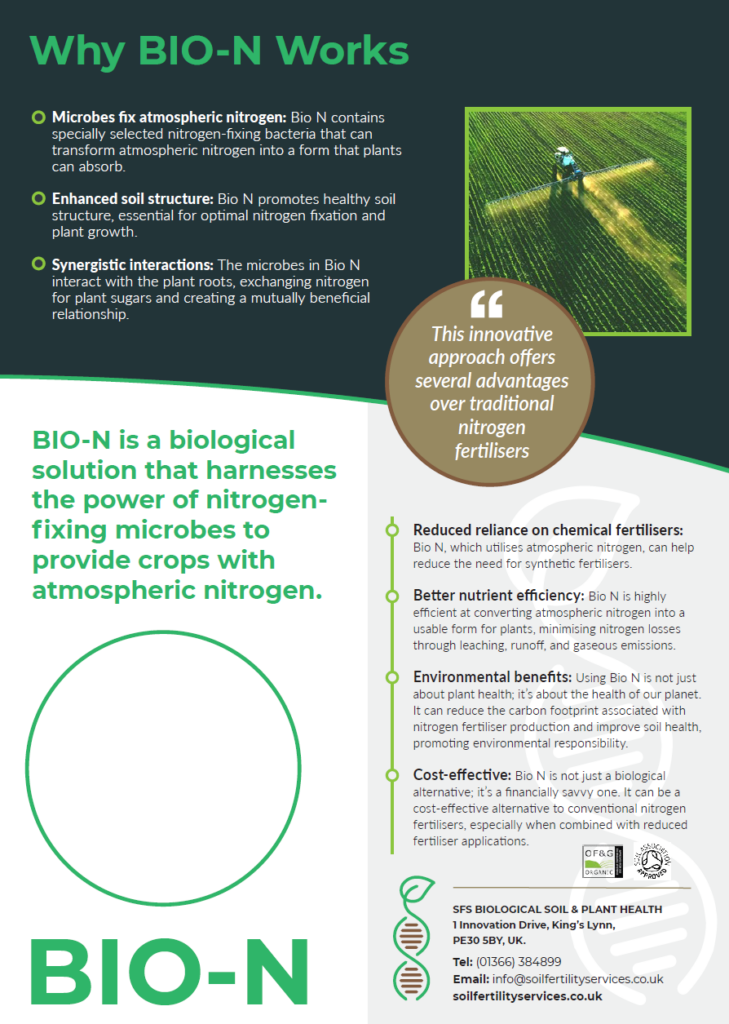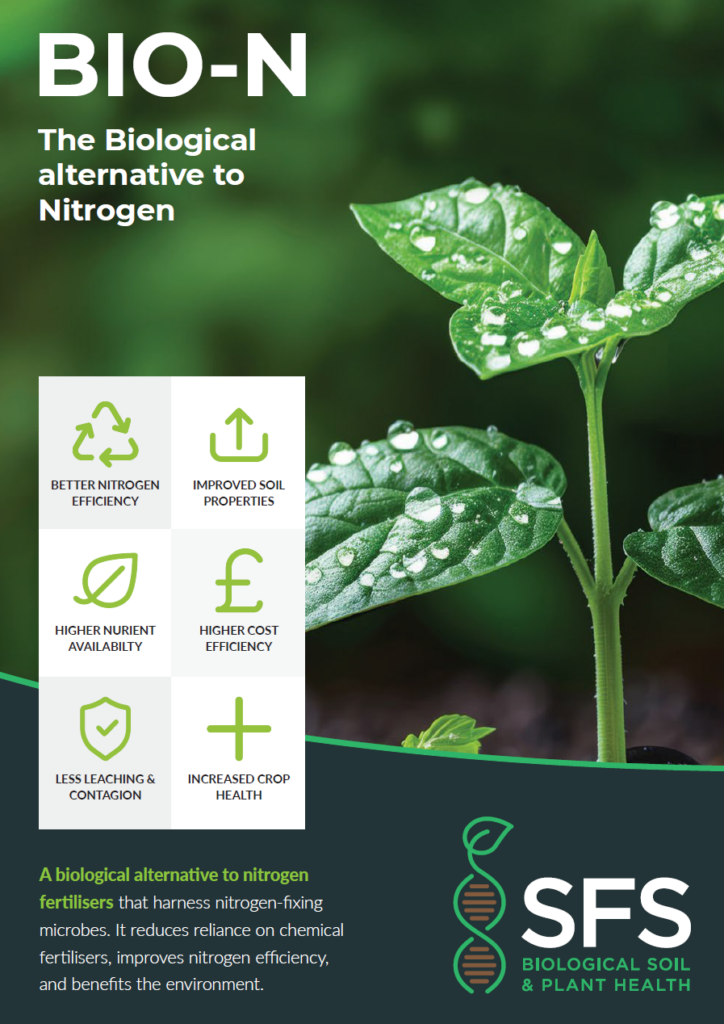Written by Chris Fellows
It’s always great to be back at the BASE Conference, where over 100 soil-focused farmers, agronomists, and researchers gathered to discuss the latest advancements in regenerative farming. The event provided an excellent opportunity to hear from leading experts, exchange ideas, and, of course, enjoy the lively conversations in the bar! Below is a summary of the key talks from the two-day event.
Day 1
Living Mulch
Speaker: Frederic Larson – Danish Agronomist with Agroganic and Farmer
Frederic Larson opened the conference with an in-depth look at living mulch systems, specifically using lucerne (alfalfa) to create a sustainable and resilient farming system. His 250-hectare farm in Denmark has been fully no-till for over a decade, starting as an effort to prevent soil erosion but evolving into an integrated system focused on maximizing plant growth and soil health.
He began with the fundamentals of intercropping, emphasizing how plants always compete for resources, but with careful selection of species, farmers can minimize direct competition while increasing overall resource use efficiency. He demonstrated that competition isn’t just about above-ground biomass but extends to root systems, which can have a greater impact when water and nutrients are limited.
The living mulch system allows for a winter cereal-dominated rotation without the need for summer cover crops. The key benefits include deeper nutrient capture, nitrogen fixation, and enhanced photosynthesis from year-round green cover. When managed correctly, lucerne can fix up to 400kg of nitrogen per hectare. However, balancing biomass is critical—too much mulch can lead to yield reductions.
Frederic detailed his four-year rotation strategy, highlighting the importance of mowing after harvest to encourage regrowth. Within two weeks, fields are covered in a dense green mat, quickly shifting from light to dark green. Mowing also contributes to silage production, yielding up to 8T/ha, with an agreement in place with a local dairy farmer to return slurry to the fields in March, effectively recycling nutrients.
He also explored the impact of glyphosate on lucerne, noting that it is relatively tolerant, allowing for low-dose applications to clean up the field after harvest. Additionally, increasing the seed rate of winter wheat by 25% helps counteract the reduced tillering caused by lucerne. Chemical mowing using ALS herbicides can replace mechanical mowing, but careful timing is essential to prevent the living mulch from overtaking the cereal crop.
The financial breakdown showed a significant economic advantage, with nitrogen savings, dairy feed revenue, and reduced cover crop costs outweighing the expenses of mulch establishment, mowing, and seed drilling. However, Frederic cautioned that this system introduces complexity, requiring careful management and adaptation.
Key takeaways:
- Living mulch can generate up to 400kg of nitrogen per hectare.
- Mowing triggers rapid regrowth, enhancing ground cover within weeks.
- The system presents challenges in balancing biomass and yield, requiring careful nitrogen and mowing management.
- Financially, the system resulted in a net gain of 910 euros per hectare through nitrogen savings, dairy feed production, and reduced cover crop costs.
- Long-term implications include weed suppression, improved soil structure, and potential for multiple lucerne cuts annually.
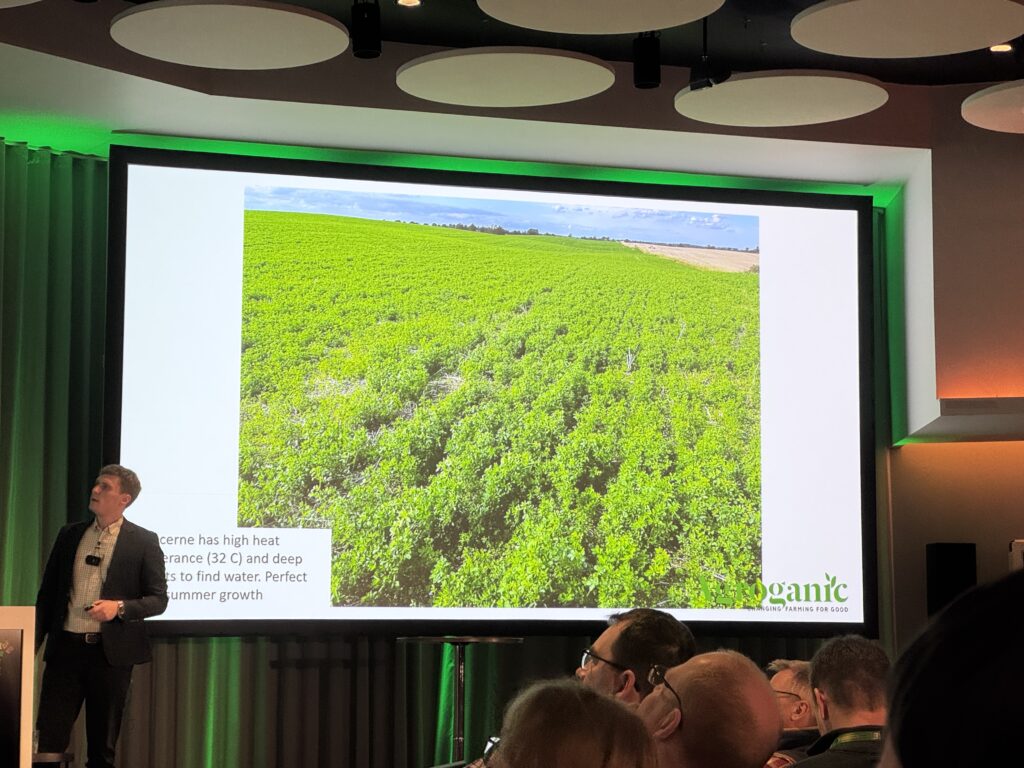
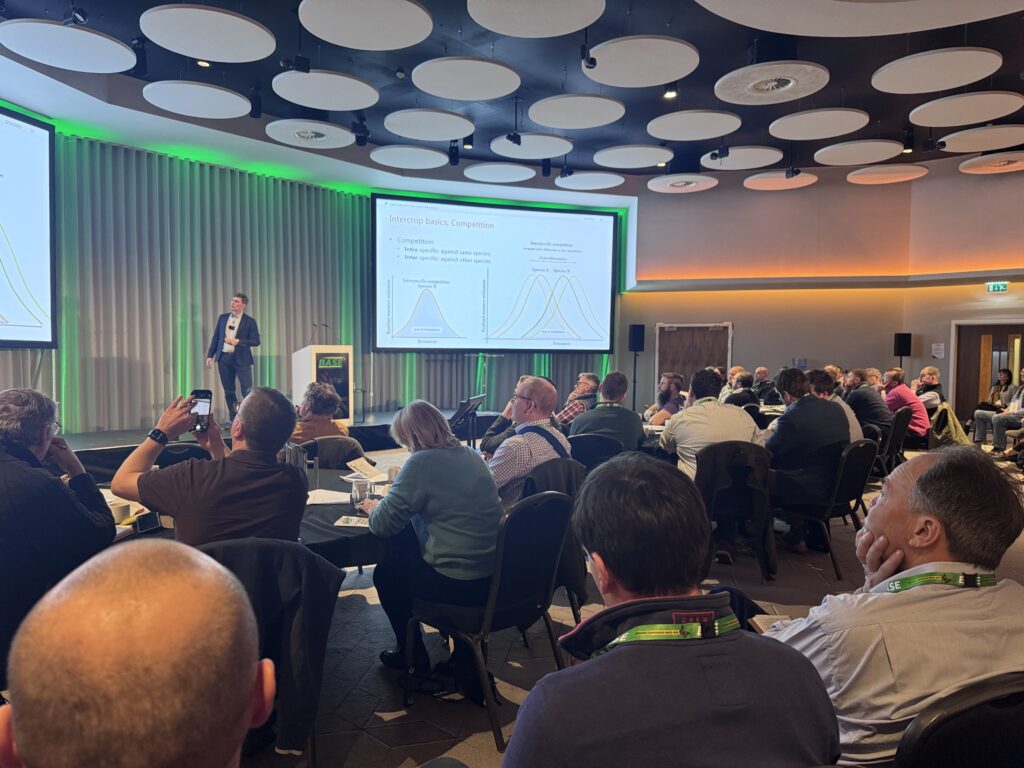
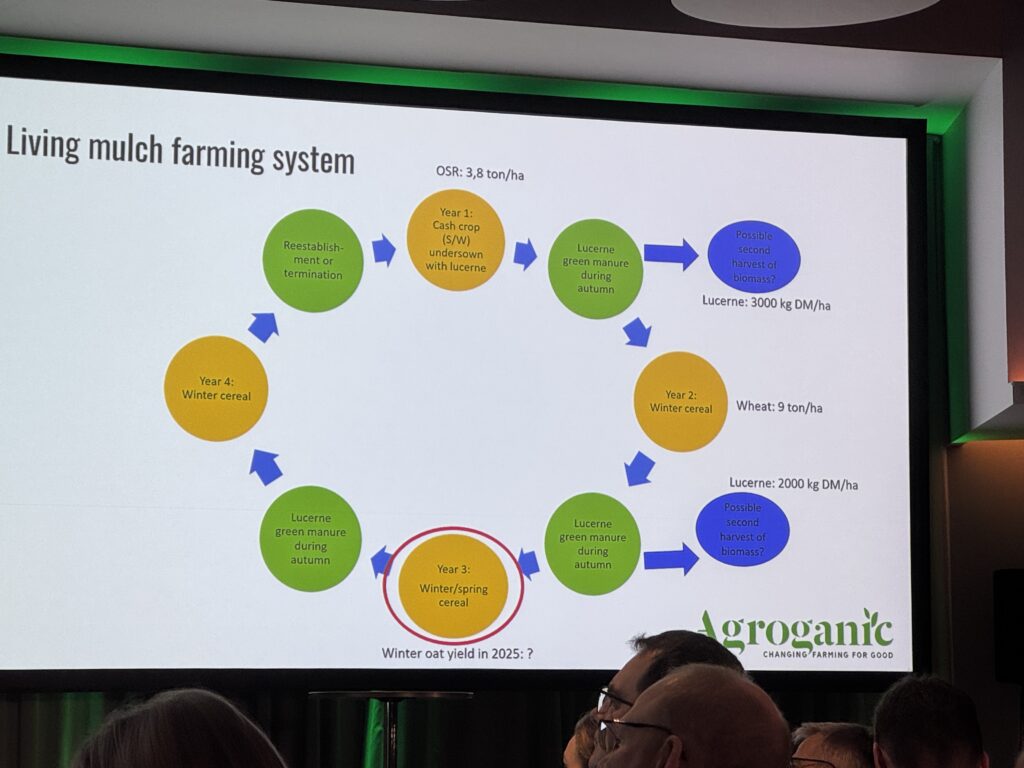
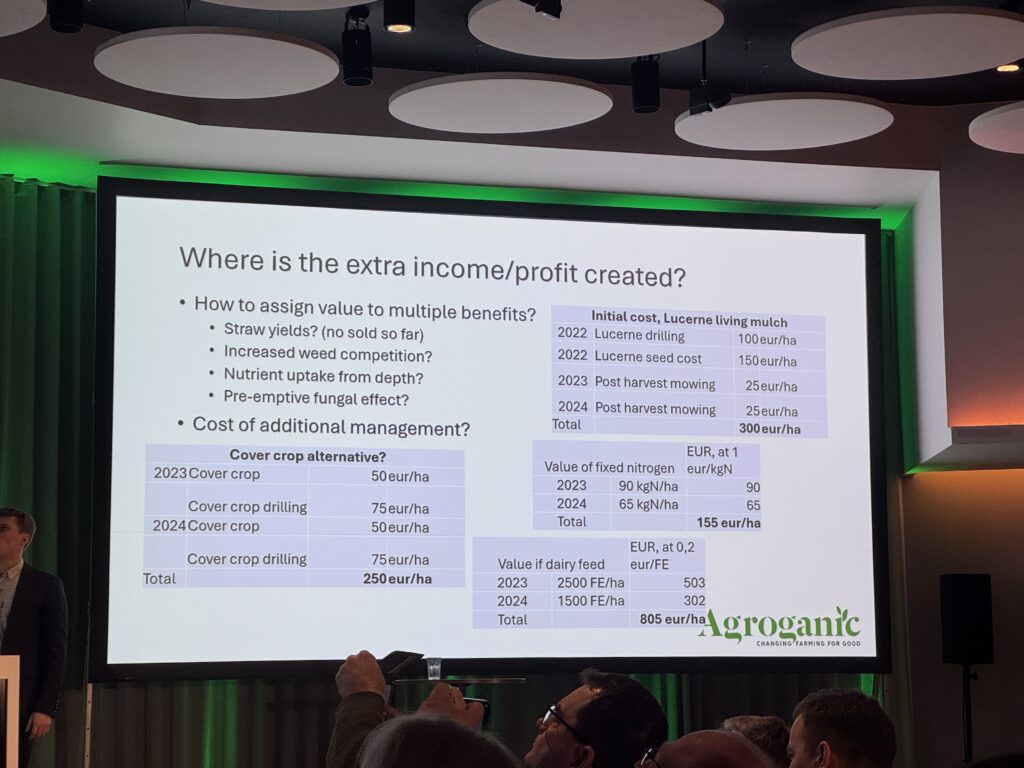
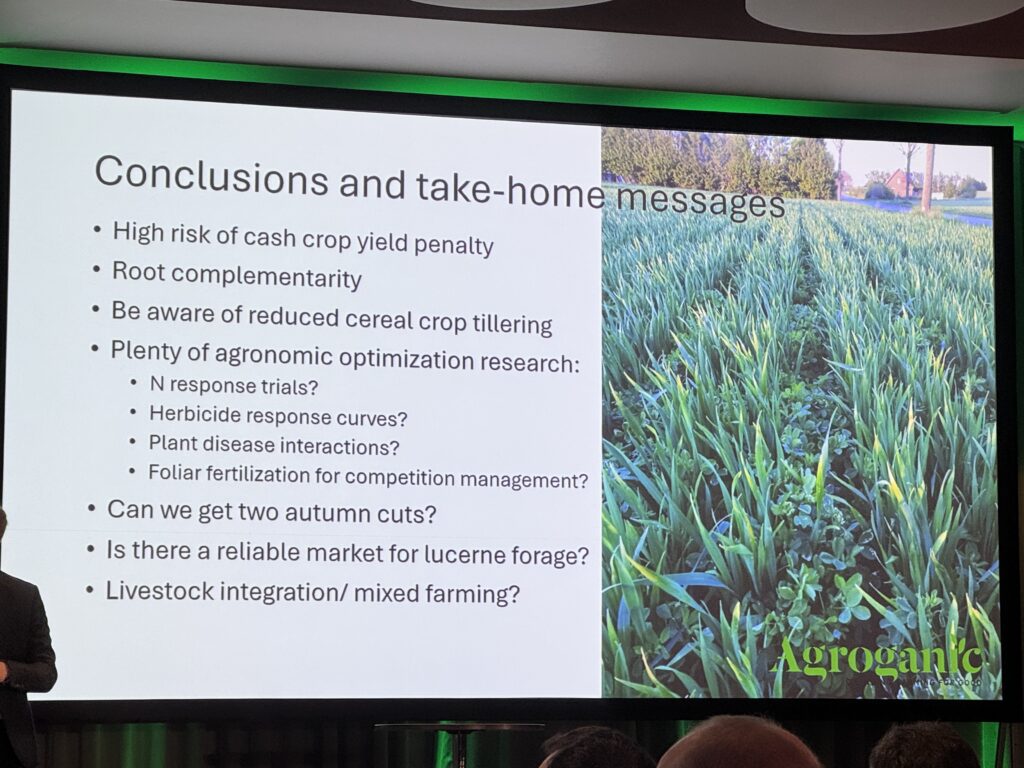
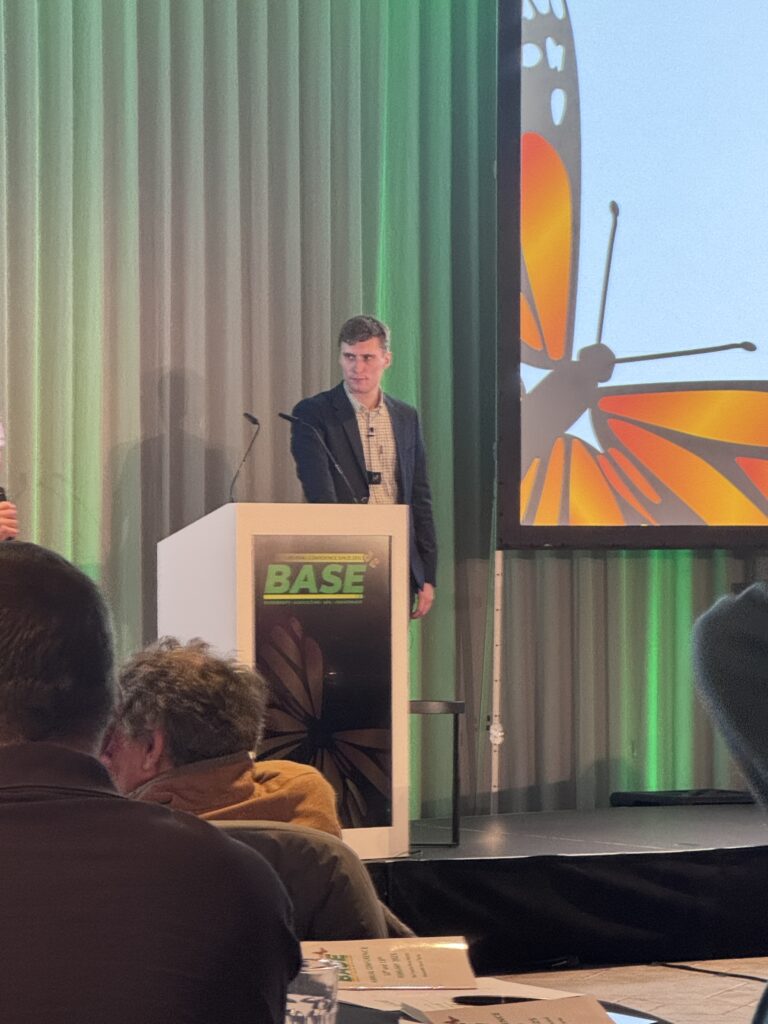
Conservation Agriculture Systems Research Experiment
Speaker: Dr. Joe Collins, Harper Adams University
Dr. Joe Collins presented a long-term research trial comparing conventional and no-till farming systems. Conducted on a 10-hectare site with 24-meter tramlines, the experiment aims to provide real-world economic data for farmers transitioning to no-till. Unlike many small-scale academic studies, this trial uses local contractors and standard farming equipment to reflect commercial realities.
Early findings suggest that while there are already observable differences in soil structure, input use, and crop yields, the most significant divergence is expected after three years. Interestingly, while no-till reduces fertilizer, fuel, and pesticide use, the differences are not as drastic as some proponents claim. The real value of this study lies in tracking the transition process over time, offering practical insights into long-term soil health and economic viability.
Key insights:
- Notable divergence in yields and input reductions emerges after three years.
- Early data shows fuel, fertiliser, and pesticide reductions, though initial yield differences are minor.
- Long-term insights will help farmers make informed transition decisions.
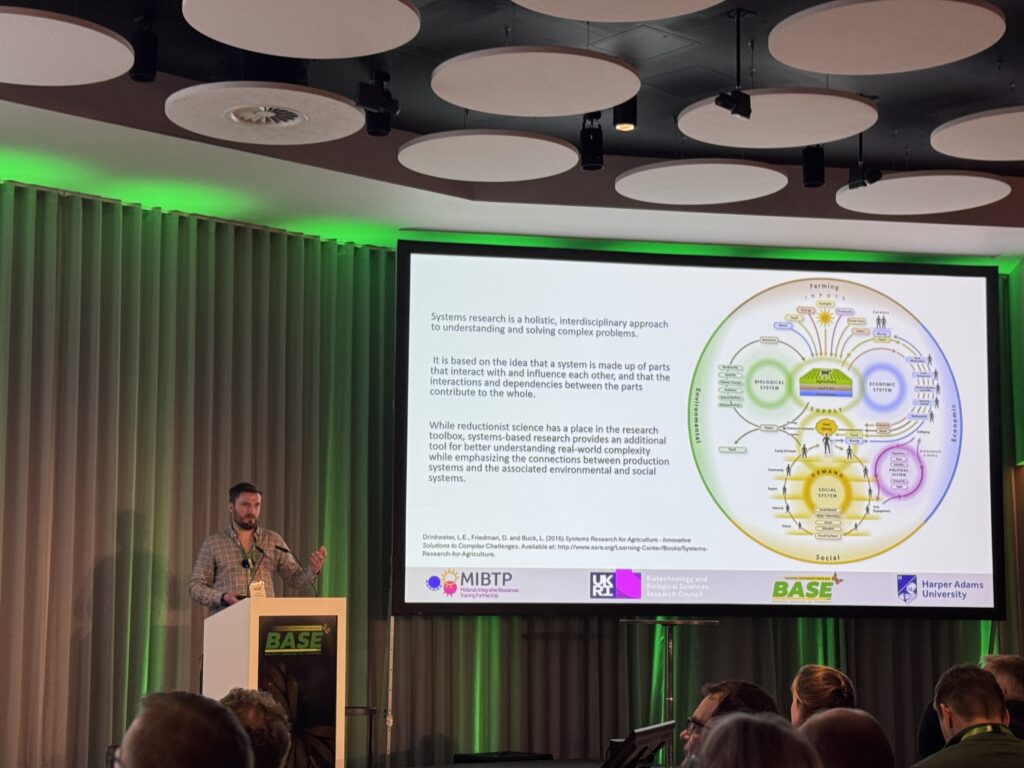
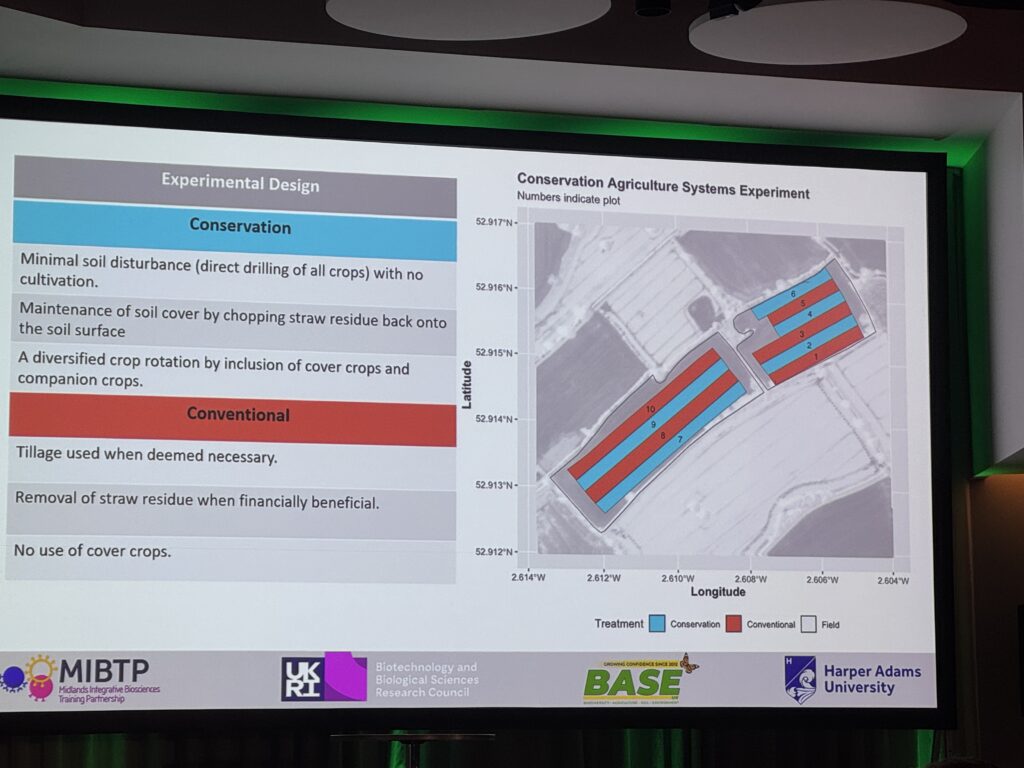
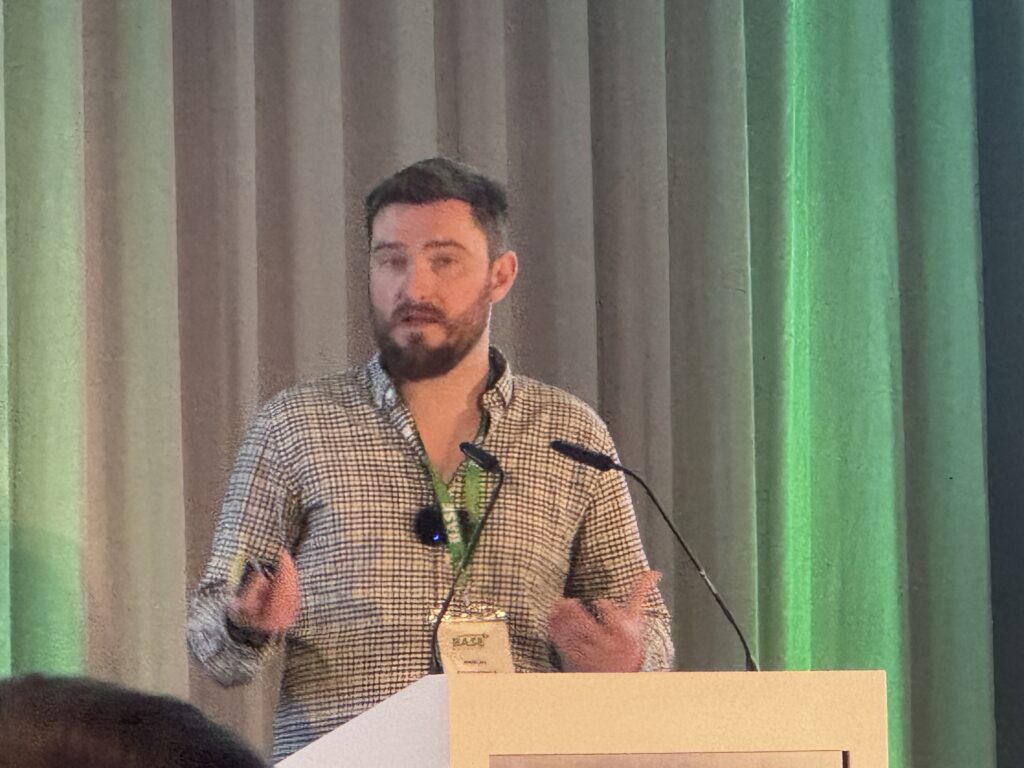
Commercial Regenerative Vegetable Production – Oxymoron or Reality?
Speaker: John Sansome, Farmer from Worcestershire
John Sansome tackled the challenge of applying regenerative principles to vegetable farming. Given the intensive nature of vegetable production, some argue that true regenerative farming is impossible in this sector. However, John demonstrated how integrating diverse crop rotations, cover crops, and livestock can significantly reduce inputs while maintaining profitability.
Through strip tillage, cover cropping, and sheep grazing, John has successfully reduced soil disturbance and improved soil biology. His conclusion? Regenerative vegetable farming is not an oxymoron—it’s a challenging but achievable goal. Success requires adapting principles to specific crops and business conditions rather than following a rigid framework.
Key Points:
- Strip tillage, cover cropping, and sheep integration as key strategies.
- Business-driven decision-making is essential for sustainability.
- While challenges remain, regenerative vegetable production is a viable and evolving reality.
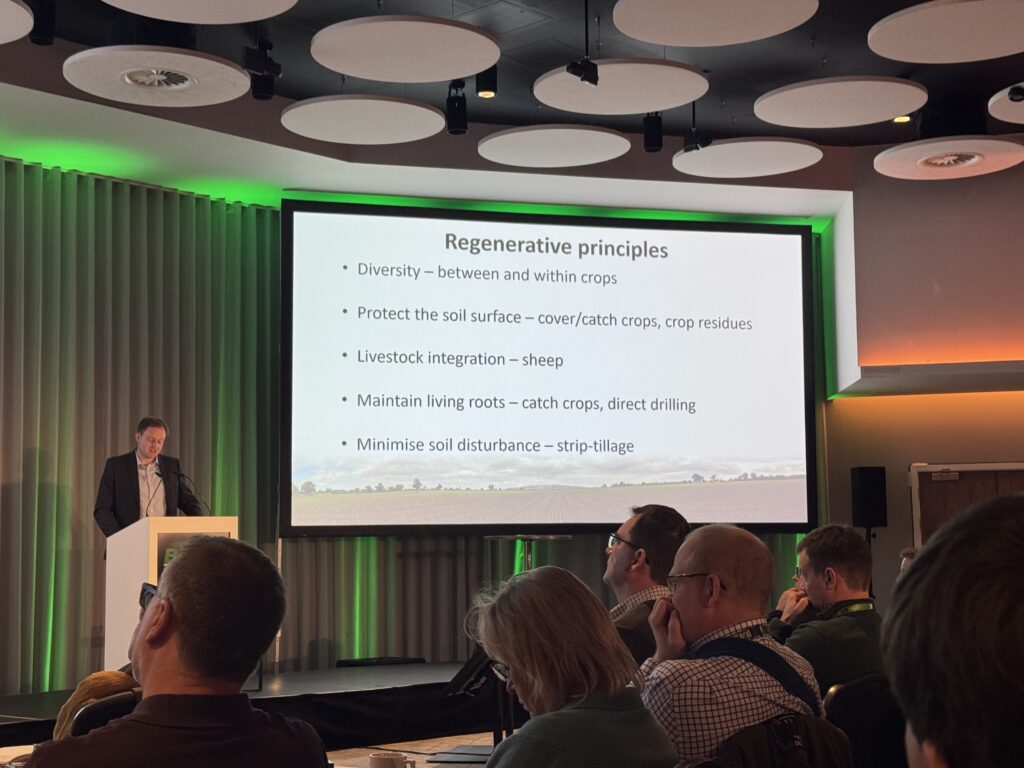
Building Soil Health to Build Farm Resilience
Speaker: Stuart Johnson, Farmer from Northumberland
Stuart Johnson was refreshingly candid about his motivation for adopting regenerative agriculture—it started purely as a financial decision. Over time, however, he has witnessed profound improvements in soil health, resilience, and overall farm profitability.
By integrating agroforestry, diverse livestock species, and compost teas, Stuart has built a more self-sustaining system. He emphasized that while mixed farming allows for more comprehensive regenerative practices, arable farmers can still adopt many principles to improve soil health and profitability.
Key points:
- Mixed farming systems offer greater flexibility in regenerative practices.
- He has integrated agroforestry, compost teas, and diverse livestock.
- Regen practices have built long-term farm resilience.
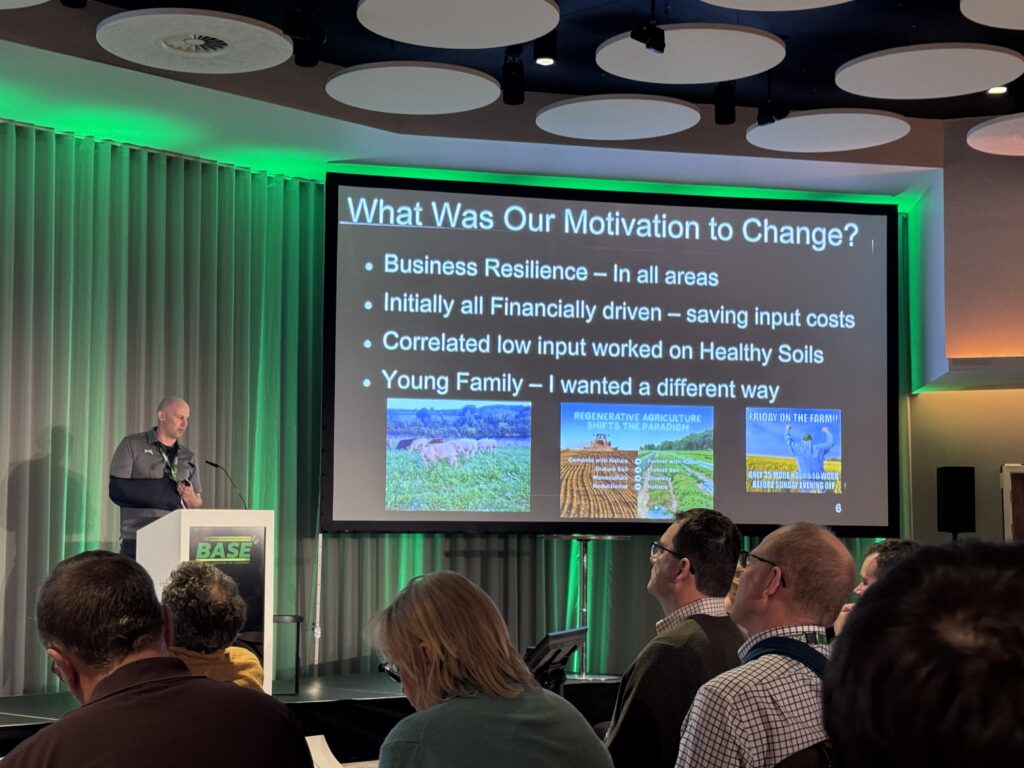
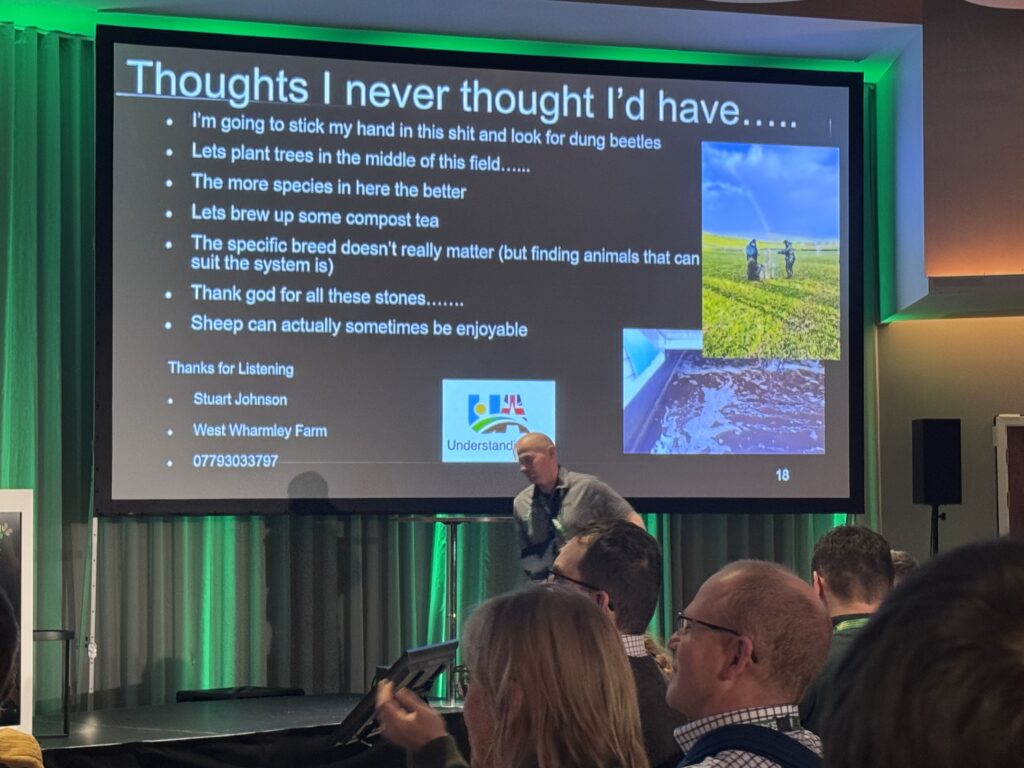
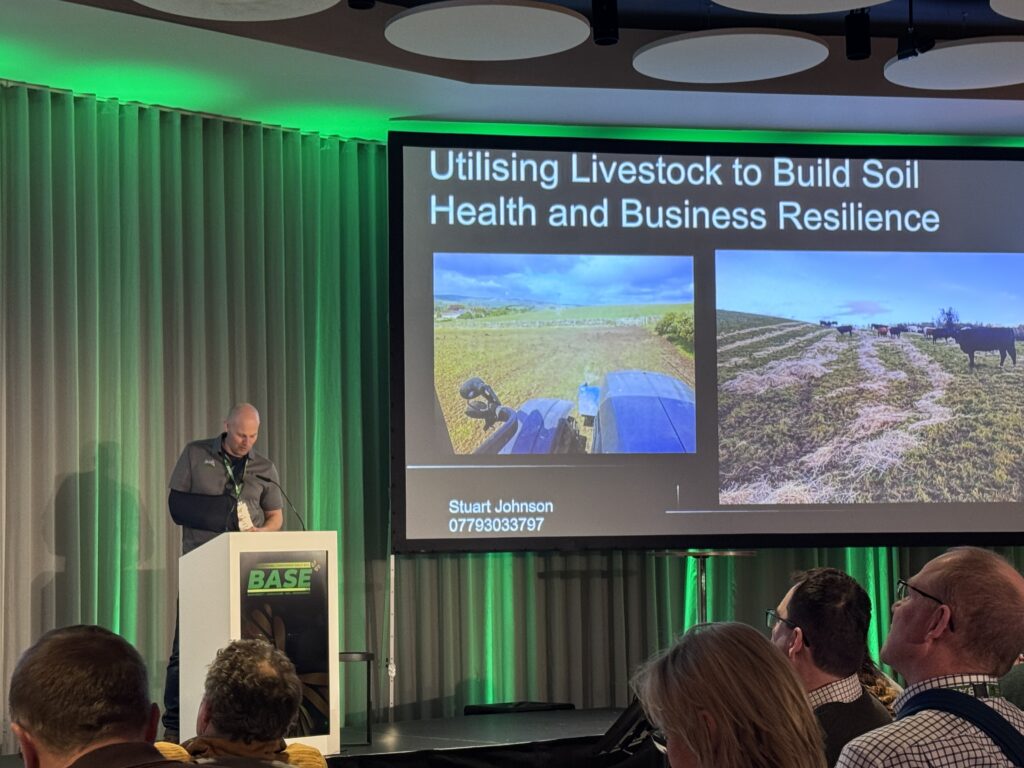
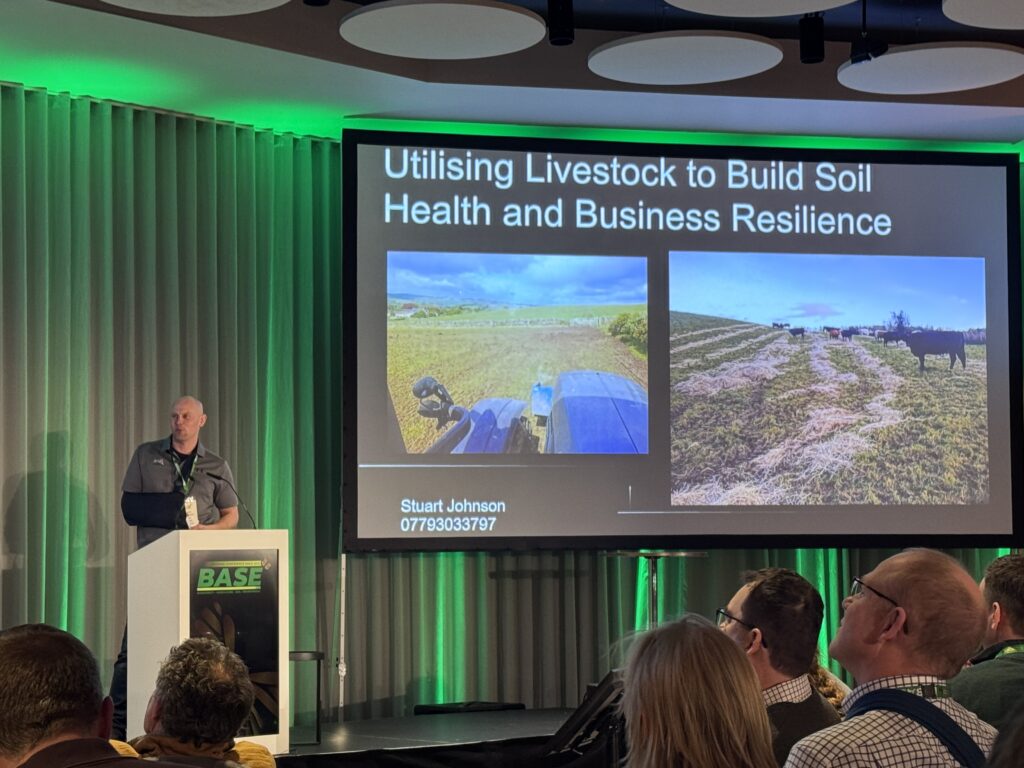
Using SFI to Stay Afloat While Underwater
Speaker: Rob Buckley, Farmer from Yorkshire
Rob Buckley shared his journey from aerospace engineering back to his family farm during COVID-19. His talk focused on the challenges and opportunities within the Sustainable Farming Incentive (SFI) scheme.
His farm has suffered from severe flooding, but he highlighted how SFI measures such as overwinter bird seed mixes have unexpectedly helped control ryegrass weeds. He cautioned that while SFI payments are helpful, once enrolled, flexibility is limited, making it difficult to pivot when conditions change.
- Highlighted bureaucratic rigidity in SFI schemes.
- Showcased the positive impact of AHL2 bird mixes on ryegrass suppression.
- Used humour to reflect on the adaptation challenges faced by many farmers. Which is a good point – I think you need a good sense of humour to be a regen farmer – as you do have your failures along the way.
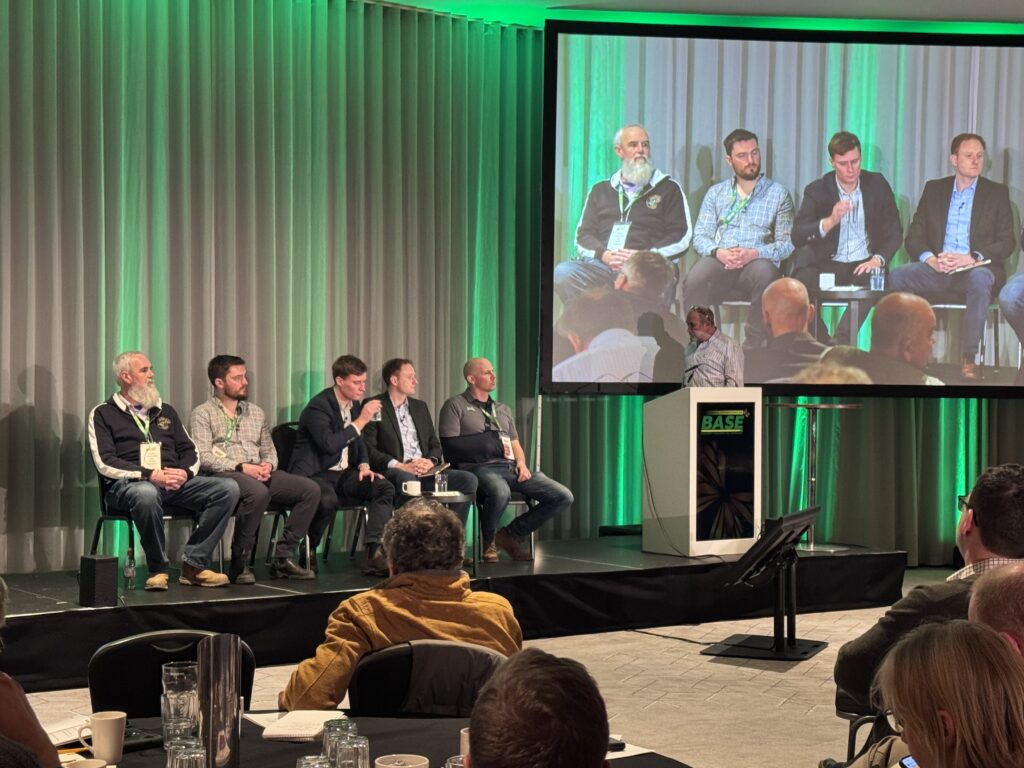
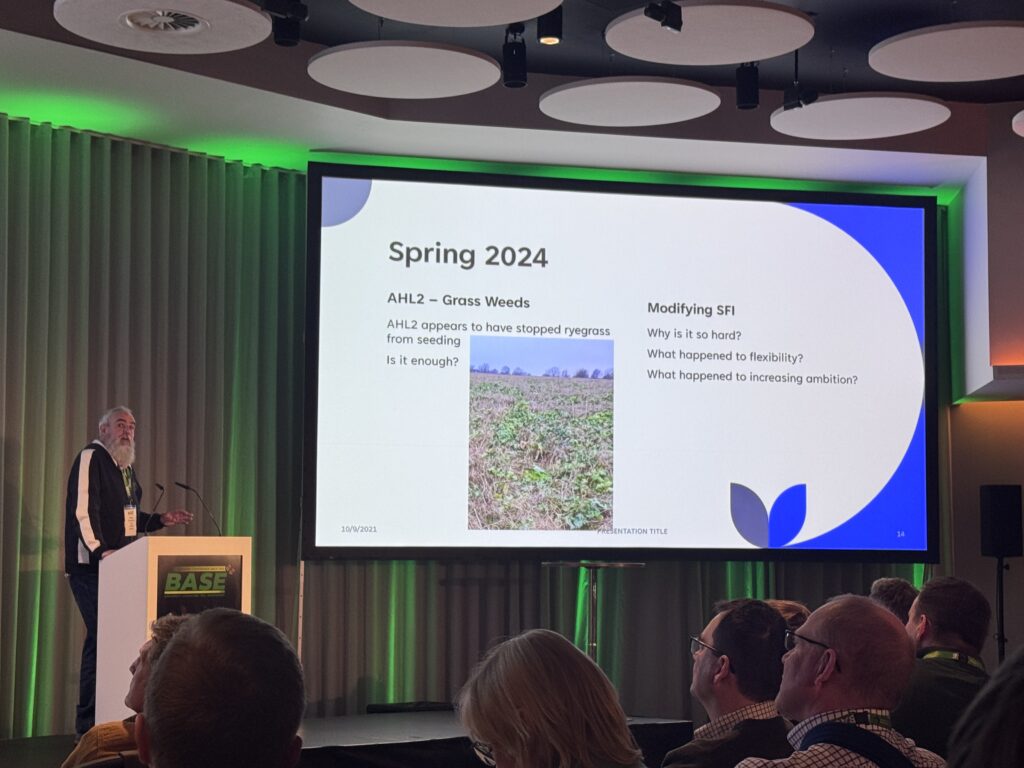
Day 2
Regenerating Soil with Soil Biology – Back to Basics
Speaker: Dr. Kris Nichols, Food Water Wellness Foundation
Dr. Kris Nichols delivered a captivating talk on soil biology, emphasizing the role of mycorrhizal fungi in nutrient cycling and plant health. She challenged misconceptions, including the claim that soil formation takes thousands of years, arguing that with proper management, soil can regenerate much faster.
Takeaways included the importance of maintaining continuous plant cover, promoting carbon sequestration, and fostering beneficial microbial interactions. She stressed that no-till “stops the bleeding,” but true soil regeneration requires active biological management.
Key points included:
- Carbon is the foundation of soil health, and regenerative soils store more carbon.
- No-till prevents further loss but must be combined with biological inputs.
- Farmers should embrace biodiversity to enhance soil function.
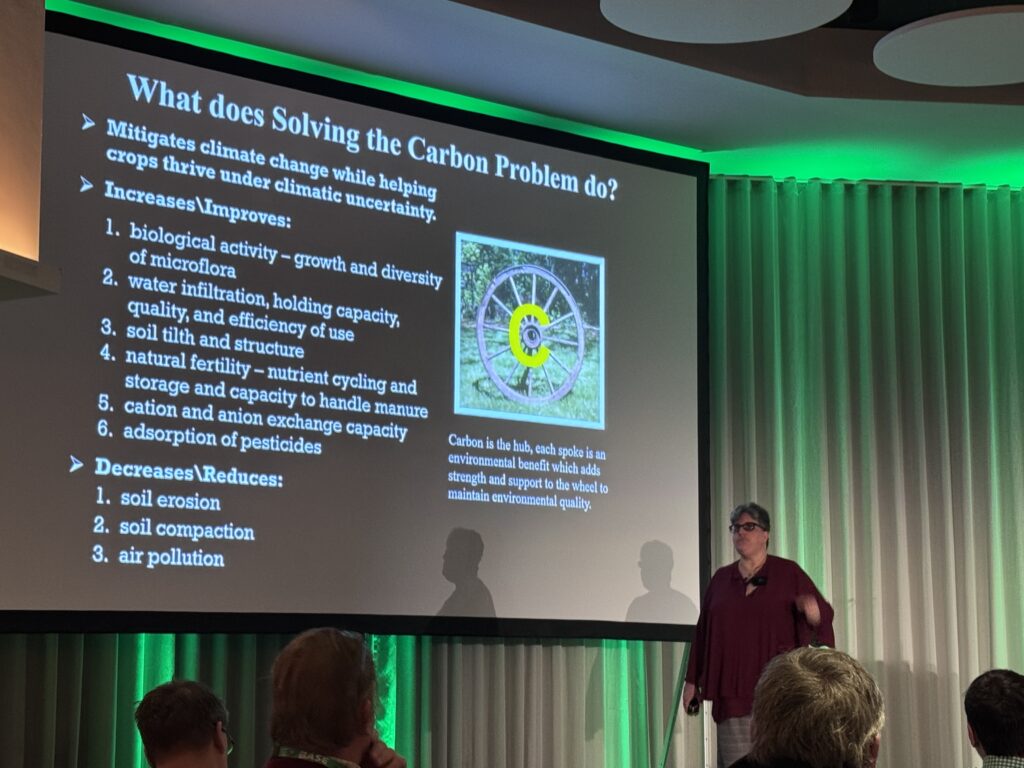
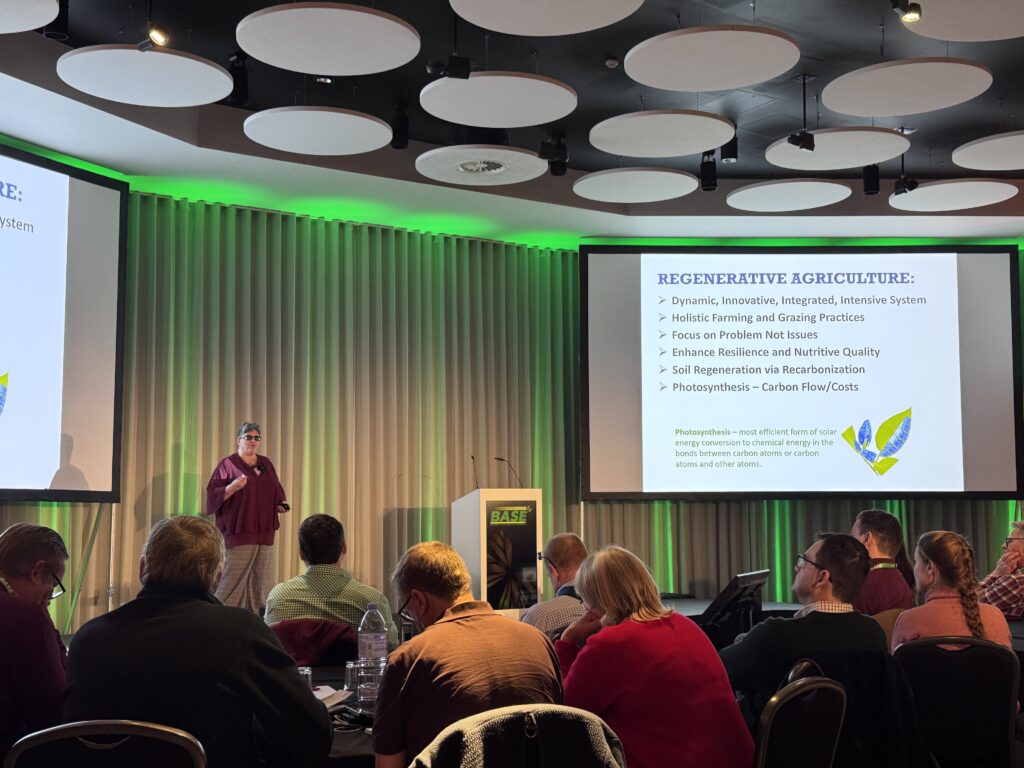
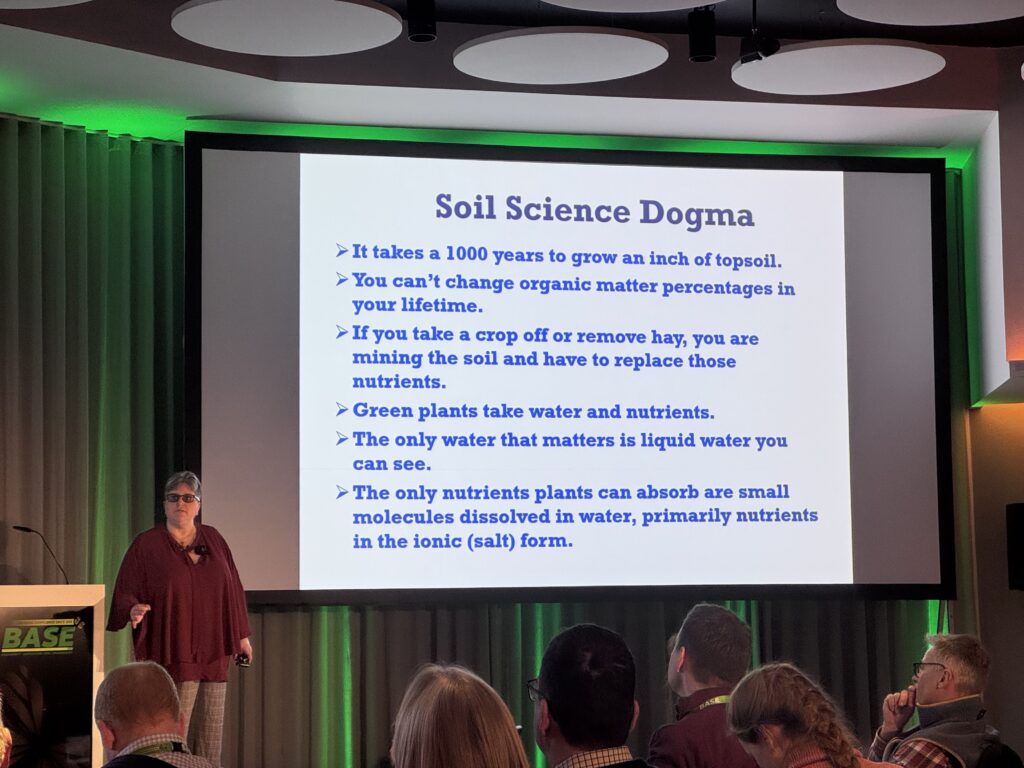

Nature-Based Food Solutions
Speaker: Professor Wendy Russell, University of Aberdeen
Professor Russell explored how crop selection can enhance both human health and agricultural sustainability. She discussed research on barley-based bread, showing its potential health benefits. She also examined alternative protein crops such as fava beans, lupins, buckwheat, and peas.
Hemp emerged as a promising crop, offering a sustainable alternative to imported soy. Trials showed that feeding hemp meal to chickens improved egg nutritional quality, raising vitamin and omega-3 content. Despite these benefits, supply chain inertia remains a barrier to widespread adoption.
Key points:
- Barley bread trials showed potential health benefits.
- Hemp production presents a low-carbon alternative to imported soy.
- Feeding trials on chickens demonstrated significant nutritional improvements in eggs when using hemp-based feed.
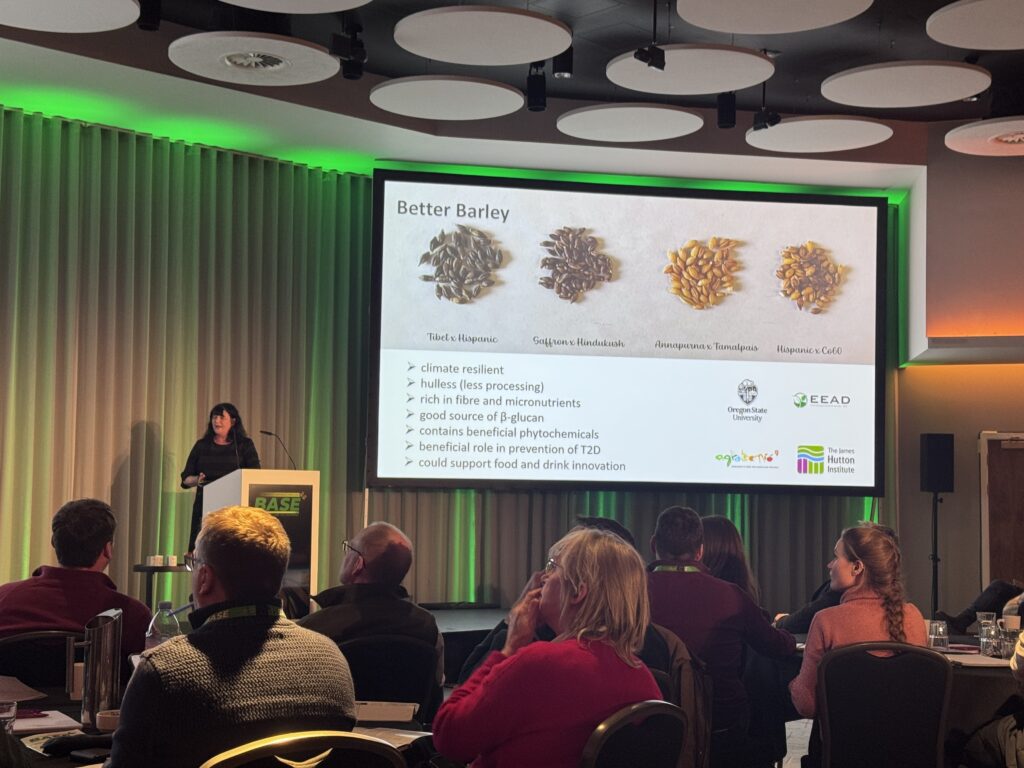
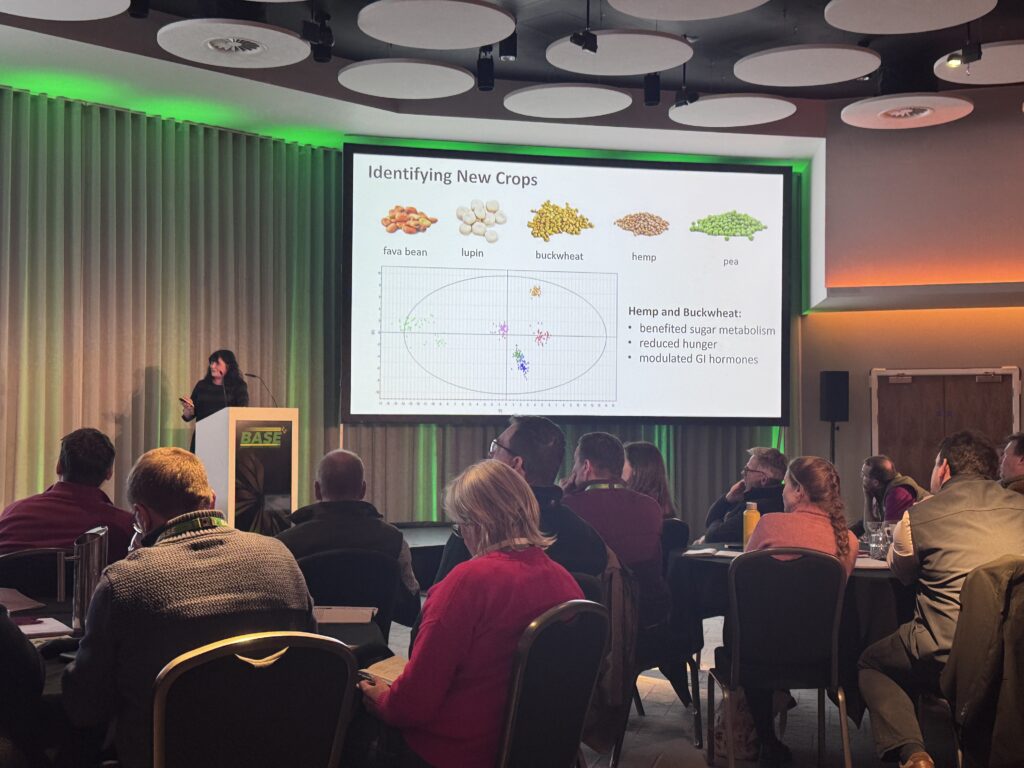
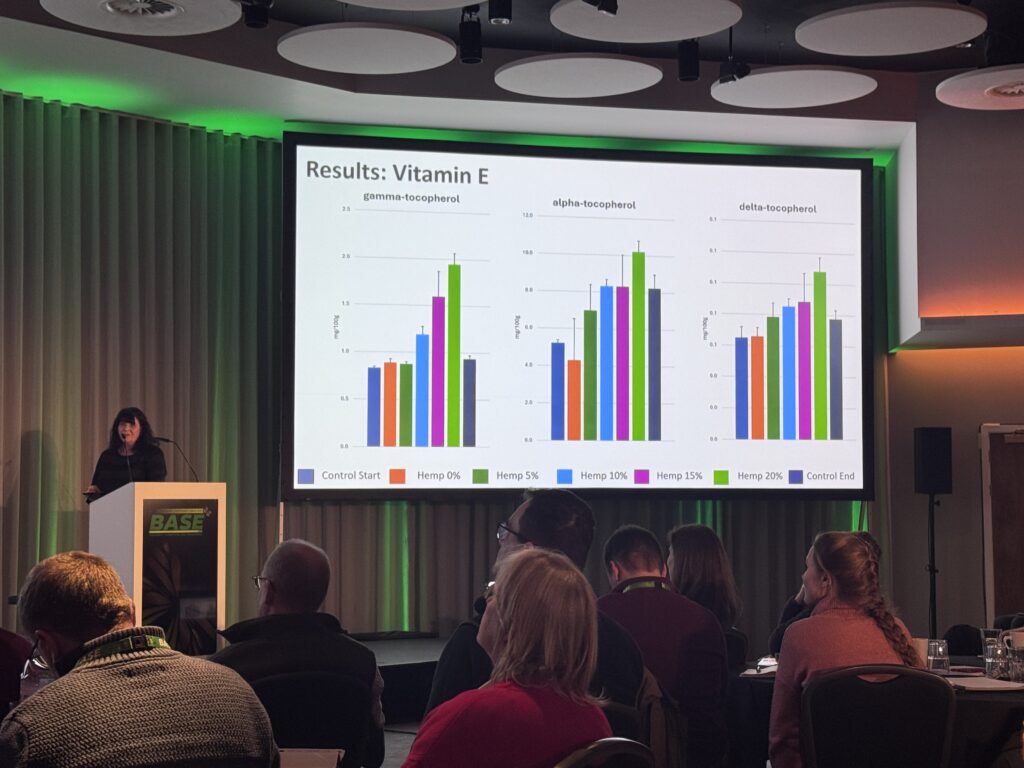
The Impact of Regenerative Farming on Soil Organic Carbon
Speaker: Charlotte Cook, Indigro Agronomist
Charlotte Cook presented compelling data from Indigro’s farm network, demonstrating that regenerative systems can maintain high yields while reducing inputs. She highlighted how strategic use of SFI schemes can improve break crop margins. Her message was clear: regenerative agriculture isn’t just about sustainability—it’s also good business.
Charlotte presented survey data from Indigro farmers showing that regen farms can maintain high yields while reducing inputs.
- Farms with over six years of regenerative practices showed improved resilience.
- Leveraging SFI schemes can enhance financial returns.
- Regen agronomy is economically viable when applied strategically.
Some great results on the sequestration of regen farms and their ability to still hit high yields. This data allows Indigro to show their customers that you can move to a regen system on the basis of its economics. “It’s just good farming”. But it was noted that these regen farms are doing a lot of regen activities and have been doing it for over 6 years. So have already built in resilience to their soils.
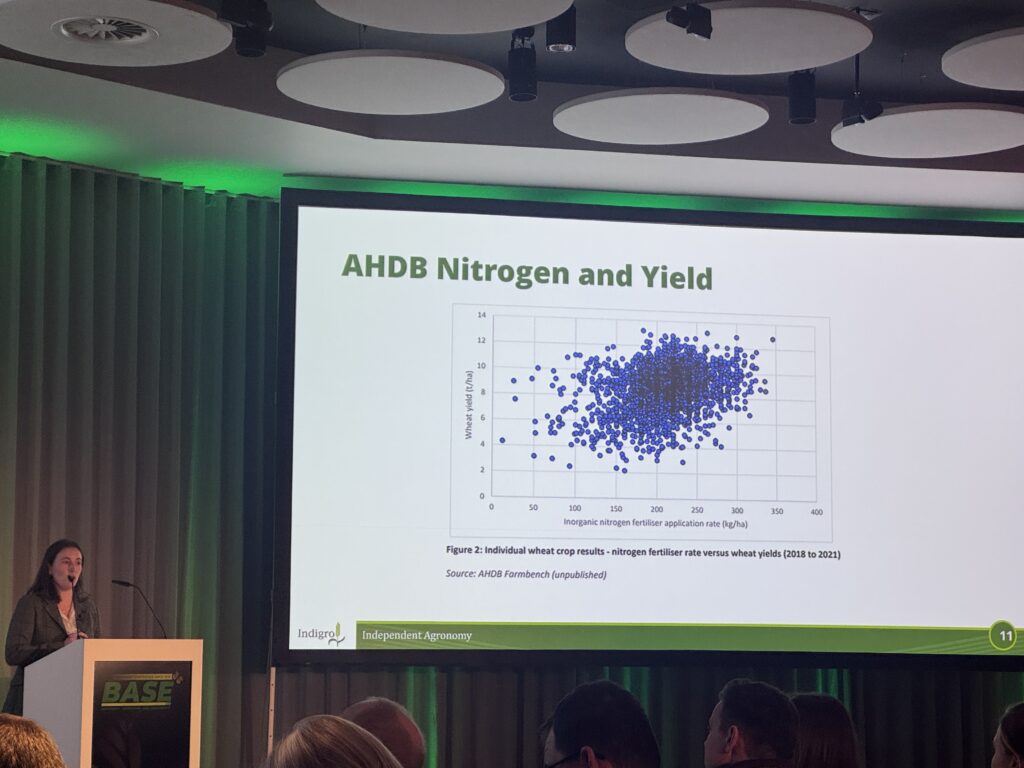
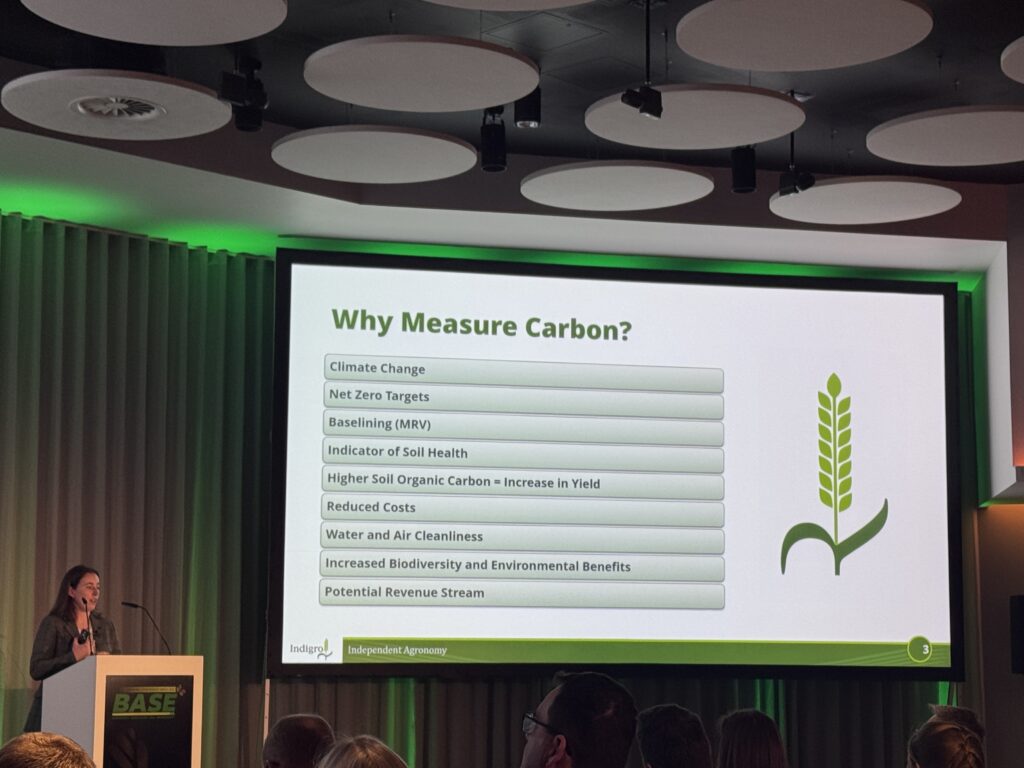
Reaching Across the Aisle
Speaker: Tom Martin, Farmer and Storyteller
Tom Martin gave an engaging talk on farmer communication. He emphasized that farmers are among the most credible sources of information about food production. By sharing their stories, they can build consumer trust and demand for regenerative products.
Tom emphasized the importance of farmer-led communication in educating consumers.
- Farmers are among the most trusted sources of agricultural information.
- Encouraged farmers to share their regen journey with the public.
- Demonstrated how storytelling enhances consumer engagement.
- You are a credible voice and that you should get involved in sharing your voice to your consumers.
This talk also showed that practice makes perfect. Tom was easily the best speaker over the two days. He natural and compelling way of speaking was clearly from the amount of it he has done before and probably a natural talent to begin with. But I know from my own experience the more you do, the better you get.
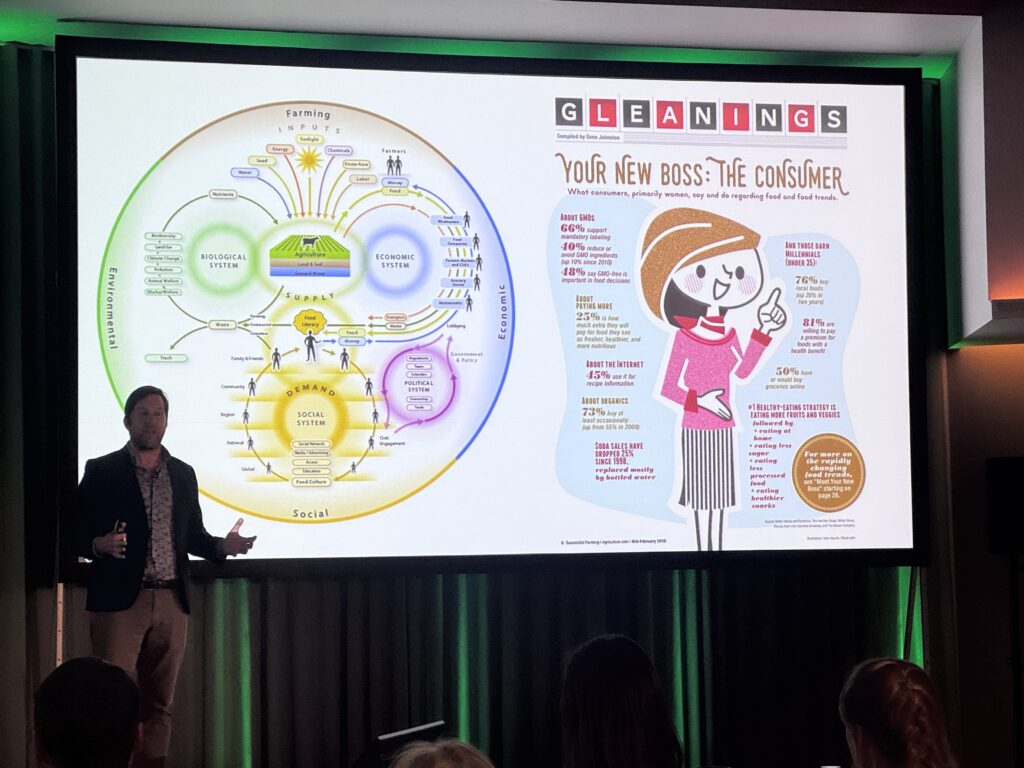
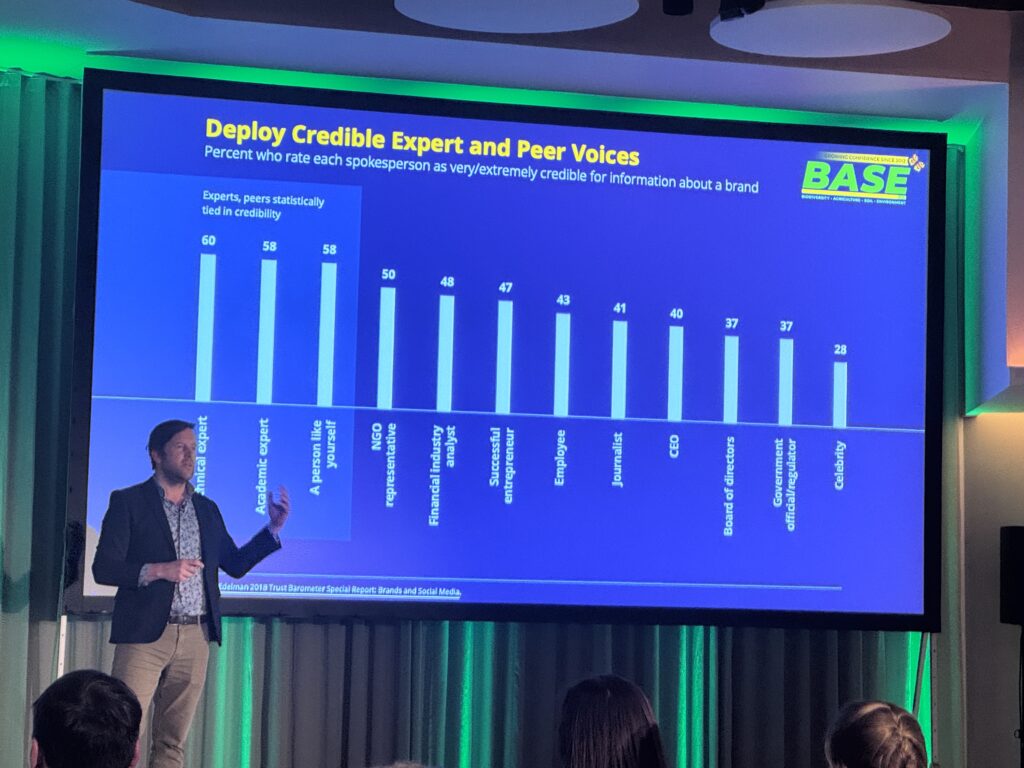
Report from Sustainable Food Conference
Speakers: Ana Reynolds & Seb Richardson
Ana and Seb summarized key takeaways from Sustainable Food 2025:
- Retailers struggle with Scope 3 emissions and regenerative transition goals.
- Supermarkets lack clear strategies and await government mandates.
- Farmers’ groups like BASE UK could play a role in shaping UK policy.
It seems that the processors and supermarkets are waiting for the government to push changes to them. They can reformulate if they want to, but only seem to change when they have to. Again they could change labelling if they wanted to. The big questions is where is the money for systems change going to come from? Retailers don’t want it to come from them.
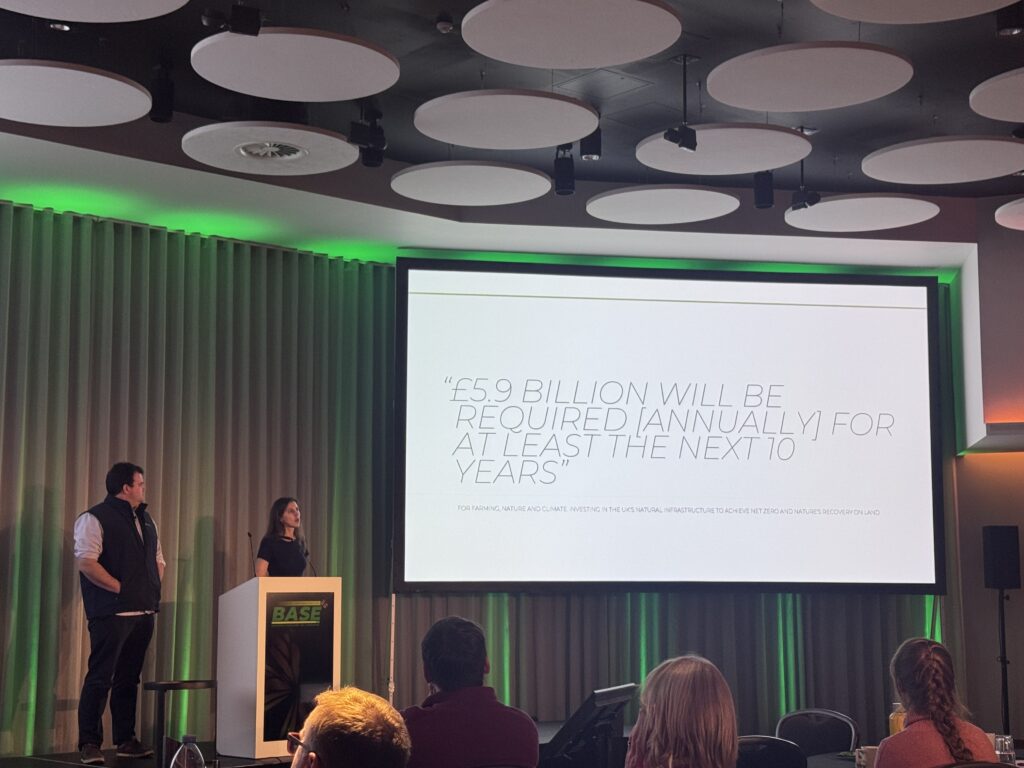
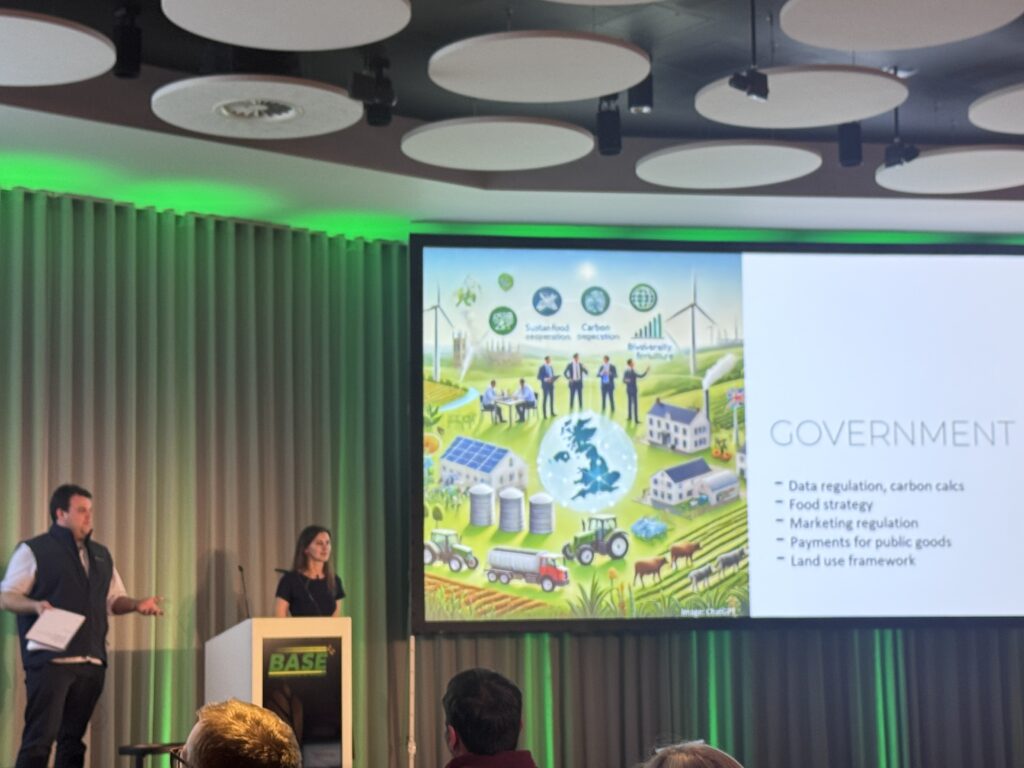
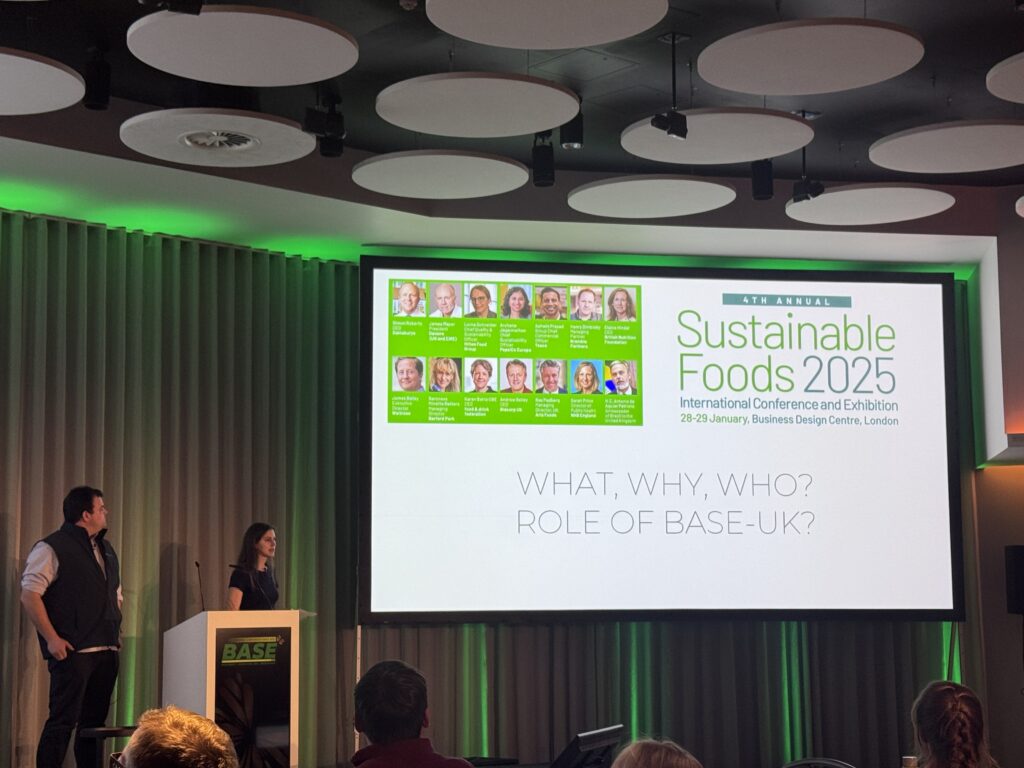
Wrap-Up
Speaker: Edwin Taylor, Chairman, BASE UK
Edwin closed the conference with a simple yet powerful message:
“It’s all about better farming.”
Not just from a profit basis, but also for future generations to inherit the farm in a better condition as well as producing better food for the public as well.
Regenerative agriculture is about profitability, sustainability, and improving farms for future generations. The conference reinforced that success in regen farming comes from continuous learning, adaptation, and farmer-to-farmer collaboration.
Final Thoughts
The BASE UK Conference 2025 provided insightful discussions on soil health, regenerative practices, and policy challenges. Each speaker brought unique perspectives, reinforcing that regen farming is an evolving journey rather than a fixed destination.
As always, it wasn’t just the talks that made the event—it was the conversations, connections, and, of course, did I mention the time spent in the bar!
